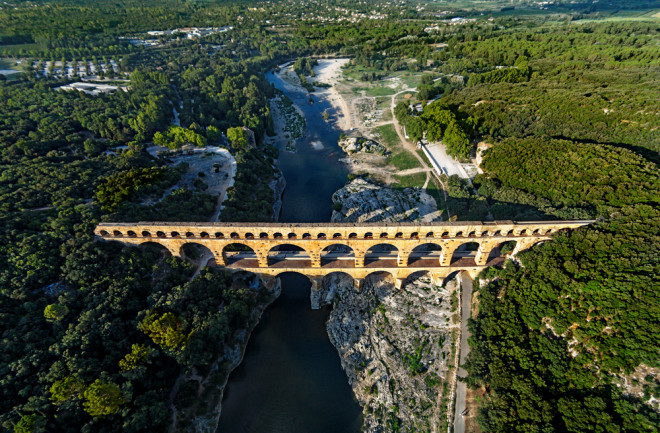Ancient Rome was a thirsty place. The city was adorned with lush gardens and dramatic fountains. Its citizens took steaming public baths and enjoyed running water delivered to their homes — and sewage carried away. Rome’s booming industries used vast amounts of water to power machinery and create goods for the city, which had a population of roughly half a million to 1 million people at its peak.
None of this would have been possible without the 11 Roman aqueducts that supplied water to the capital from the surrounding countryside. The Roman aqueducts were a crowning technological achievement of the ancient world. Rome’s first aqueduct was built in 312 B.C., and many more would be built over the next five centuries.
They didn’t invent the idea of using aqueducts to move millions of gallons of freshwater, though. The Assyrians, Greeks, Egyptians and more had all used aqueducts to supply dry, thirsty cities. But the aqueducts of ancient Rome stand out thanks to their grand scale and breathtaking architecture, which often used elevated bridges to pass water across valleys and over urban areas. In fact, some carry water even now, some 2,000 years later.
Roman Aqueducts: Ancient Technological Marvels
Aqueducts route water over long distances using gravity alone. For the concept to work, though, it needs to be built with staggering precision. Some Roman aqueducts slope just a foot or two per mile, according to the U.S. Geological Survey. And while their stunning, arched stone architecture may have made aqueducts famous, the vast majority of Roman aqueducts were actually built underground. Builders knew that by keeping them covered and protecting the water from sunlight, they’d avoid contaminants and stave off algae.
Roman aqueducts didn’t only supply water to Rome, either. Over the centuries, the ancient Roman empire grew to conquer much of Europe, Northern Africa and Western Asia. And as its military spread across the globe, Roman culture often replaced local traditions with its language, alphabet, calendar and technology. As a result, Roman aqueducts can still be visited across the ancient world.
Roman builders constructed these monumental works of public infrastructure in far-off places like Great Britain and Morocco, where fast-growing civilizations also needed ample fresh water. There are dozens of known examples found in Europe, Africa and Asia.
In France, a first century A.D. Roman aqueduct called the Pont du Gard delivered water over dozens of miles to the then Roman city of Nîmes.
In Spain, the Aqueduct of Segovia reaches nearly 100 feet tall on its highest bridge and dates to around the second century A.D. It provided water to the city from a river roughly 10 miles away.
In Syria and Jordan, builders of the Roman empire spent more than a century constructing a monumental system of channels, tunnels and bridges called the Gadara Aqueduct. Just one section was 60-miles long. It carried water from a now-dry swamp to the booming league of 10 ancient cities called the Decapolis, creating an oasis in the desert.
In Tunisia, the second century A.D. Zaghouan Aqueduct supplied the ancient city of Carthage with water from more than 80 miles away, making it among the longest Roman aqueducts.
In Turkey, the eastern Roman empire capital of Constantinople was supplied with water from the Aqueduct of Valens, which was constructed in the fourth century A.D. The city used it for centuries, and ruling governments maintained the aqueduct long after the Roman empire collapsed.
The Fall of the Roman Empire
Modern engineers still marvel at these feats, yet Rome’s emperors often had access to resources that, thankfully, aren’t common today. They wielded unilateral control of their nation and could utilize slave labor to marshal grand projects. In fact, that was part of the point. While the aqueducts may have served a practical purpose, they also doubled as a sign of Rome’s power abroad.
And yet aqueduct construction sometimes faced familiar hurdles. For example, in 19 B.C, the Roman general and legendary builder, Agrippa, was constructing a new aqueduct, the Aqua Virgo, which approached the city from the east. But as the project reached the eastern suburbs, local property owners resisted in a form of 2,000 year old NIMBYism, according to the book Rome: An Urban History from Antiquity to the Present. Agrippa was forced to divert the aqueduct to the north on a much longer course and negotiate a mix of public and private land use. Rome even went as far as appointing a key landowner along the route as the city’s first water commissioner, perhaps in exchange for his allegiance.
Construction of new aqueducts — and other projects — ultimately faded across the Roman empire in the centuries leading up to its collapse in A.D. 476. And in the centuries that followed, the aqueducts would repeatedly fall into neglect and disrepair, only to be saved by last-ditch repair efforts that kept clean water flowing to the city of Rome.
In fact, the Aqua Virgo, the aqueduct that Agrippa so carefully orchestrated, still flows through the city today. It’s a reminder of humanity’s technological prowess even in antiquity. And it shows us what’s possible with enough planning and imagination — and a bit of careful negotiation.

